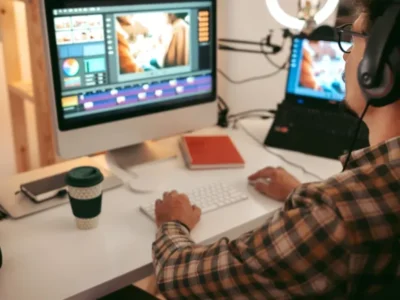How to become a cinematographer in the film industry? This is an exhilarating yet challenging journey. The competitive nature of the field demands not only technical prowess but also a relentless pursuit of creative excellence. In this comprehensive guide, we will explore the traditional paths to becoming a cinematographer and shed light on a third option—a hybrid approach that connects diverse methods.

The Traditional Paths: Film School vs. On-Set Experience
Film School: Beyond Gear and Technique
Film schools often get lauded for providing students with access to cutting-edge gear and imparting technical know-how. However, the true value lies in the environment they create. Film school compels aspiring cinematographers to churn out films regularly, fostering an atmosphere that nurtures creativity and hones the craft. More importantly, it acts as a networking hub where future collaborations and professional relationships are forged.
Consider the case of acclaimed DOP Emmanuel Lubezki, whose collaboration with director Alfonso Cuarón found its roots in their shared film school experience. The bonds formed in these educational institutions often transcend into successful professional partnerships.
While film school can potentially fast-track a cinematography career, it’s not an instant ticket to becoming a DOP. Talent needs to be complemented by practical experience, and there are financial barriers to attending film school that many aspiring cinematographers may encounter.
On-Set Experience: Climbing the Hierarchy
An alternate route involves starting at the grassroots level on film sets, typically as a Production Assistant. This journey involves gradually ascending the hierarchical ladder—choosing a specific department, learning the ropes, and eventually earning roles as a camera operator and, ultimately, a DOP.
Working on set is an immersive learning experience. It goes beyond theoretical knowledge, teaching crucial skills such as dealing with technical equipment, navigating interpersonal dynamics, and mastering the art of quick decision-making under pressure. Observing seasoned cinematographers and directors at work provides invaluable insights that can’t be gleaned from textbooks or online tutorials.
However, this traditional path is time-consuming, requiring years of dedication and networking to ascend through the ranks. It demands patience and persistence but offers a holistic understanding of the filmmaking process.
How to Become a Cinematographer: Navigating the Competitive Landscape
Navigating the Job Market
Each year, film schools churn out a multitude of graduates, each aspiring to secure a coveted cinematographer role. However, these positions are limited, and the competition is fierce. In this environment, building a successful career requires a nuanced approach.
-
Diverse Entry Points: Unlike some professions, there is no single, straightforward path to guaranteed success in cinematography. Different DOPs kickstarted their careers in varied ways, from starting as still photographers to ascending through different crew positions over years or even decades.
-
The Numbers Game: In a competitive environment with limited DOP roles, playing the numbers game by taking any available crew role can be a strategic approach. While there’s only one DOP position, numerous roles are available in production, camera, electrical, and grip departments.
Film Composition Examples
Within this FREE PDF, you will discover:
- film composition examples in movies
- how filmmakers employ composition techniques
- how to create unforgettable cinematic experiences

Building a Network and Portfolio
-
Network Building: The film industry thrives on relationships. Building a network of contacts and collaborators, especially directors and producers, is crucial for cinematographers. Film school provides a unique opportunity to forge bonds with like-minded collaborators who may become future employers.
-
Showcasing Work: Early success often hinges on building a substantial body of work. Shooting projects that gain traction online or receive accolades at film festivals can elevate your profile. A well-curated website, using platforms like Squarespace, becomes a valuable tool for showcasing your portfolio.
Tips for Building Your Cinematography Career
1. Understanding the Freelance Lifestyle
Working in the film industry means embracing a freelance lifestyle, with no guaranteed salary. Flexibility in your schedule is crucial, allowing you to seize unexpected opportunities that may arise on short notice.
2. Clarifying Your Goals
As a cinematographer, specializing in a specific niche is key. Whether your passion lies in narrative films, documentaries, or commercial work, having a clear goal helps in building a focused career path.
3. Embracing the Time Factor
Becoming an industry-level DOP is a long-term goal that demands time and dedication. While the duration may vary, aspiring cinematographers should be prepared for a career trajectory measured in years, not months.
4. Proactive Engagement
Being self-employed requires proactive efforts in seeking opportunities, reaching out to collaborators, and being open to taking on various roles, even if they initially involve unpaid or passion projects.
5. Building a Positive Reputation
Your on-set demeanor, work ethic, and the quality of your output directly impact your reputation. In a small industry, positive word-of-mouth references can significantly influence your future job opportunities.
6. Continuous Improvement
Constantly refining your skills, expanding your network, and enhancing your reel are essential components of building a successful cinematography career. Actively seek opportunities to grow, whether through hands-on experience, collaborations, or ongoing education.
How to Become a Cinematographer: Conclusion
In conclusion, embarking on the path to become a cinematographer involves a diverse journey encompassing education, hands-on experience on set, strategic networking, and a proactive approach. Navigating the traditional routes, comprehending the competitive dynamics, and applying strategic insights can significantly enhance the prospects of aspiring Directors of Photography (DOPs) in their pursuit of a successful and lasting career in cinematography. To excel in this field, continuous learning, adaptability, and an unwavering passion for the art of visual storytelling are paramount. So, whether you’re aspiring to become a cinematographer or to become a video editor, remember that success lies in the commitment to ongoing improvement and a genuine love for the craft. Happy shooting and editing!
Film Composition Examples
Within this FREE PDF, you will discover:
- film composition examples in movies
- how filmmakers employ composition techniques
- how to create unforgettable cinematic experiences

Explore related content

Video Editing Tips CapCut: Tips, Tricks, and Techniques
Video editing is an art, and there are proper tools and techniques, through them everybody… Read More »Video Editing Tips CapCut: Tips, Tricks, and Techniques

Factors to Consider Before Buying a Video Editing Computer
From helping grow your brand and business to editing just for fun with the love… Read More »Factors to Consider Before Buying a Video Editing Computer

Best Video Editing Monitors in 2024
In the evolving world of video production, the importance of a high-quality monitor cannot be… Read More »Best Video Editing Monitors in 2024